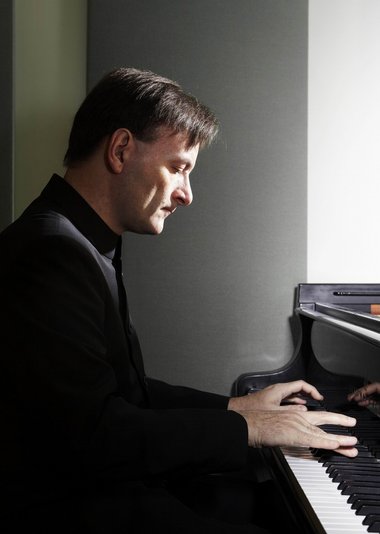Hough offers a compelling afternoon of sonata “strangeness”

Until roughly a century ago keyboard virtuosos were expected to include composition in their skill set. Specialization has largely squelched this assumption, so when a pianist the caliber of Stephen Hough programs his own work, curious pianophiles are bound to take notice.
“Strange Sonatas” was the theme given to his program Sunday at Symphony Center, and in most respects the description fit each of the four works like a glove. Its eccentricities never prevented Beethoven’s Sonata in C sharp minor (“Moonlight”) from achieving the pinnacle of fame, yet oddly enough this was the lone work in the program to come packaged in the standard multi-movement sonata structure.
Hough’s reading was anything but standard, most notably in the haunting opening movement. The famously gloomy slow arpeggios were distant and faint, testing the limits of audibility and providing headroom for other gestures to emerge, all well within the consistently hushed dynamic. His particular insistence on the primacy of low pedal points lent a disquieting air of foreboding. In this context the graceful scherzo seemed a mere calm before the turbulence of the finale, delivered cleanly and briskly but without the sense of panic often assigned to it.
The single-movement Piano Sonata No. 5 of Scriabin also tests traditional boundaries, though Hough’s commanding performance never glossed over the sonata form structure that barely contains the hair-raising excesses. His attention to detail and complete command of this shockingly dense piece never overshadowed his palpable sense of color, a prerequisite in the music of the Russian eccentric.
If that sonata sets a premium on sheer note density and structural concision, Hough’s own year-old Sonata for Piano (broken branches) is by comparison leisurely and expansive. His language is generally tonal, skipping over high modernism (or any recent compositional trend) in favor of a melodic, harmonic, and structural palette that is vaguely early 20th century in outlook, without ever explicitly channeling any particular composer. There are brief glimpses of influence, including a hint of autumnal English melancholy and an allusion to polite, Gallic-tinged jazz. Yet Hough seemed determined not to let any of these references steer his path for long.
The opening and closing phrases revealed a simple ascending scale (a branch growing outwards and upwards?) that was given various treatments and accompaniments. The work’s best asset was its willingness to make intentions clearly discernible without condescending to audiences largely unaccustomed to digesting new music. The composer himself perceptively describes its 16 sections as “inconclusive,” unfortunately creating a paradox that he’s never quite able to unwind. For all of its ingenuity, the dominance of recitative-like gestures wore thin, impeding a sense of cohesion.
The second half was given over to Liszt’s Sonata in B minor, another single-movement incarnation of the form but with mammoth ambitions. The pianist’s account was rigorous, vividly etched and occasionally impatient, without the tendentious pauses that characterize many readings. In the second half he seemed to loosen the reins, applying more generous rubato and imparting a sense of risk not sensed earlier in the program. The grand climax was driven hard, even to the limits of this artist’s security. Hough’s technical fortitude was up to the task, but the sense of danger provided listeners with the afternoon’s most exhilarating moments.
Hough treated the audience to lithe, delicate readings of two Chopin encores, the Nocturne in E flat, Op. 9, No. 2; and the Waltz in A flat, Op. 69, No.1.
Posted in Uncategorized


Posted Jun 14, 2012 at 9:38 am by Ken
Good review. I was there and I agree with most of it–thanks.